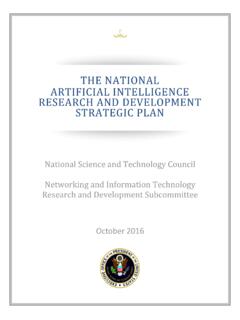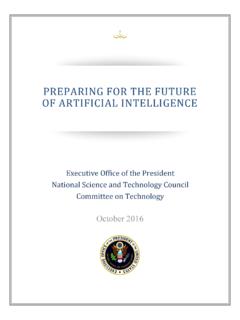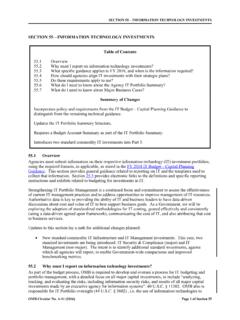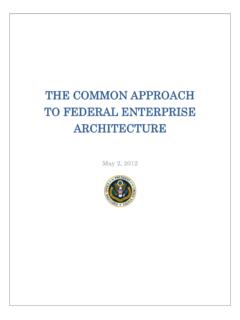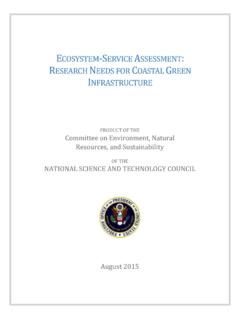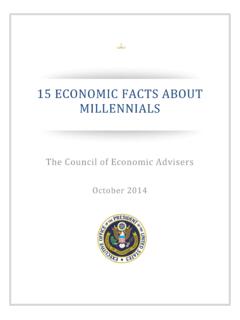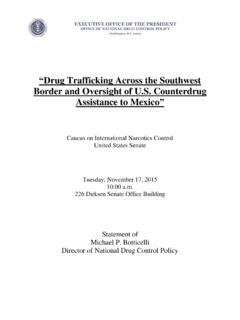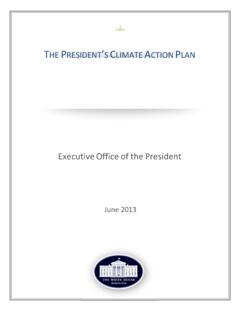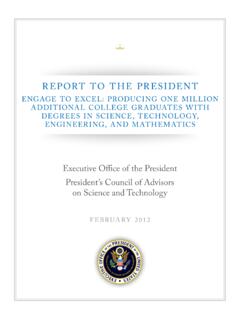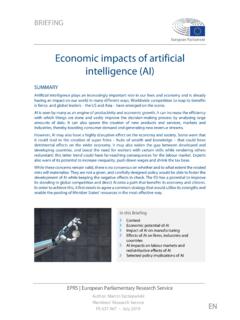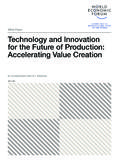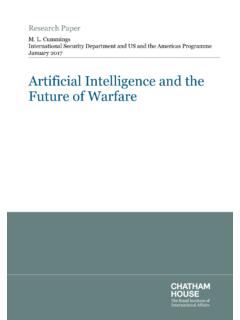Transcription of PREPARING FOR THE FUTURE Artificial Intelligence, OF ...
1 December 2016 PREPARING FOR THE FUTURE OF Artificial intelligence National Science and Technology Council Artificial intelligence , Automation, and the Economy Executive Office of the President Copyright Information This is a work of the Government and is in the public domain. It may be freely distributed, copied, and translated; acknowledgment of publication by the Executive Office of the President (EOP) is appreciated. Any translation should include a disclaimer that the accuracy of the translation is the responsibility of the translator and not EOP.
2 It is requested that a copy of any translation be sent to EOP. This work is available for worldwide use and reuse and under the Creative Commons CC0 Universal license. EXECUTIVE OFFICE OF THE PRESIDENT WASHINGTON, 20502 December 20, 2016 Advances in Artificial intelligence (AI) technology and related fields have opened up new markets and new opportunities for progress in critical areas such as health, education, energy, economic inclusion, social welfare, and the environment. In recent years, machines have surpassed humans in the performance of certain tasks related to intelligence , such as aspects of image recognition.
3 Experts forecast that rapid progress in the field of specialized Artificial intelligence will continue. Although it is unlikely that machines will exhibit broadly-applicable intelligence comparable to or exceeding that of humans in the next 20 years, it is to be expected that machines will continue to reach and exceed human performance on more and more tasks. AI-driven automation will continue to create wealth and expand the American economy in the coming years, but, while many will benefit, that growth will not be costless and will be accompanied by changes in the skills that workers need to succeed in the economy, and structural changes in the economy.
4 Aggressive policy action will be needed to help Americans who are disadvantaged by these changes and to ensure that the enormous benefits of AI and automation are developed by and available to all. Following up on the Administration s previous report, PREPARING for the FUTURE of Artificial intelligence , which was published in October 2016, this report further investigates the effects of AI-driven automation on the job market and economy, and outlines recommended policy responses. This report was produced by a team from the Executive Office of the President including staff from the Council of Economic Advisers, Domestic Policy Council, National Economic Council, Office of Management and Budget, and Office of Science and Technology Policy.
5 The analysis and recommendations included herein draw on insights learned over the course of the FUTURE of AI Initiative, which was announced in May of 2016, and included Federal Government coordination efforts and cross-sector and public outreach on AI and related policy matters. Beyond this report, more work remains, to further explore the policy implications of AI. Most notably, AI creates important opportunities in cyberdefense, and can improve systems to detect fraudulent transactions and messages. Jason Furman John P. Holdren Chair, Council of Economic Advisers Director, Office of Science and Technology Policy Cecilia Mu oz Megan Smith Director, Domestic Policy Council Chief Technology Officer Jeffrey Zients Director, National Economic Council Artificial intelligence , AUTOMATION, AND THE ECONOMY Artificial intelligence , AUTOMATION, AND THE ECONOMY Contents Executive Summary.
6 1 Economics of AI-Driven Automation .. 1 Policy Responses .. 3 Conclusion .. 4 Outreach and Development of this Report .. 5 Introduction .. 6 Economics of AI-Driven Automation .. 8 AI and the Macroeconomy: Technology and Productivity Growth .. 8 AI and the Labor Market: Diverse Potential Effects .. 10 Historical Effects of Technical Change .. 11 AI and the Labor Market: The Near Term .. 13 What kind of jobs will AI create? .. 18 Technology is Not Destiny Institutions and Policies Are Critical .. 21 Policy Responses .. 26 Strategy #1: Invest In and Develop AI for its Many Benefits.
7 27 Strategy #2: Educate and Train Americans for Jobs of the FUTURE .. 30 Strategy #3: Aid Workers in the Transition and Empower Workers to Ensure Broadly Shared Growth .. 34 Conclusion .. 43 References .. 44 Artificial intelligence , AUTOMATION, AND THE ECONOMY Artificial intelligence , AUTOMATION, AND THE ECONOMY 1 Executive Summary accelerating Artificial intelligence (AI) capabilities will enable automation of some tasks that have long required human These transformations will open up new opportunities for individuals, the economy, and society, but they have the potential to disrupt the current livelihoods of millions of Americans.
8 Whether AI leads to unemployment and increases in inequality over the long-run depends not only on the technology itself but also on the institutions and policies that are in place. This report examines the expected impact of AI-driven automation on the economy, and describes broad strategies that could increase the benefits of AI and mitigate its costs. Economics of AI-Driven Automation Technological progress is the main driver of growth of GDP per capita, allowing output to increase faster than labor and capital. One of the main ways that technology increases productivity is by decreasing the number of labor hours needed to create a unit of output.
9 Labor productivity increases generally translate into increases in average wages, giving workers the opportunity to cut back on work hours and to afford more goods and services. Living standards and leisure hours could both increase, although to the degree that inequality increases as it has in recent decades it offsets some of those gains. AI should be welcomed for its potential economic benefits. Those economic benefits, however, will not necessarily be evenly distributed across society. For example, the 19th century was characterized by technological change that raised the productivity of lower-skilled workers relative to that of higher-skilled workers.
10 Highly-skilled artisans who controlled and executed full production processes saw their livelihoods threatened by the rise of mass production technologies. Ultimately, many skilled crafts were replaced by the combination of machines and lower-skilled labor. Output per hour rose while inequality declined, driving up average living standards, but the labor of some high-skill workers was no longer as valuable in the market. In contrast, technological change tended to work in a different direction throughout the late 20th century. The advent of computers and the Internet raised the relative productivity of higher-skilled workers.
